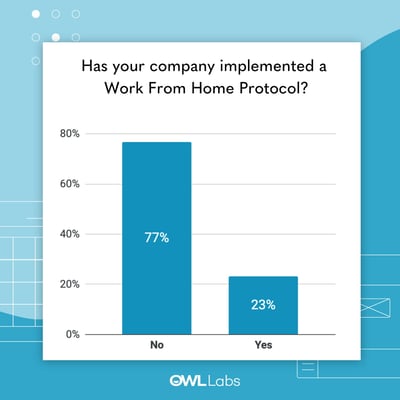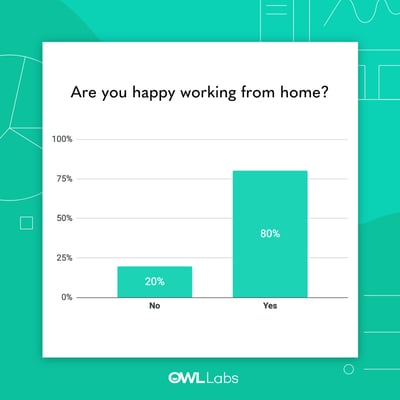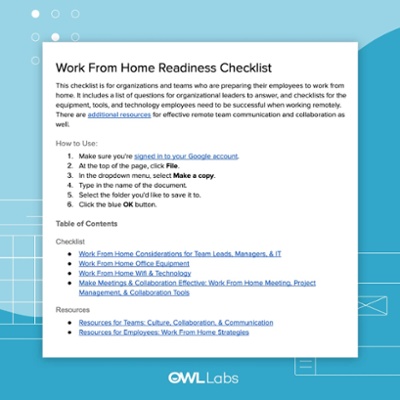The current climate and concern around Coronavirus (COVID-19) is putting strong pressure on employers to consider the best possible means to keep their employees and the community healthy and safe.
Many companies are looking to work from home options as a solution, providing guidance and tools to support it. With that in mind, the Owl Labs team wanted to understand the elements that have had the most impact on work-from-home readiness.
Report Findings: Working From Home in Response to Coronavirus
This week we ran a study surveying 1,239 full-time employees across the United States to understand how prepared companies are in the event all employees are required to work from home. Here's what we learned.
1. Are Companies Prepared For All Employees to Work From Home?
Our study found that 66% of people think their company is somewhat to very prepared, but a remaining 34% of respondents thought their companies were not.
We dug in to understand what elements contributed to an organization's sense of preparedness. The overarching theme was that if organizational leaders took the responsibility of providing clear communication and work from home guidance, employees were much more likely to use good judgment to better the health of themselves and their fellow colleagues, as well as feel a better sense of readiness overall.
2. Sending Company-Wide Communication About COVID-19
Among the group of respondents who felt very prepared for a full "working from home" rollout, 75% had received a company-wide message about Coronavirus (COVID-19). In fact, respondents were 3X more likely to feel prepared than others if they received a company-wide message.
However, there was a divide among companies that were taking action on messaging and those who were not. A company with 50+ employees was 2X more likely to issue an official message about Coronavirus (COVID-19) to employees than companies with 50 or fewer.
.jpg?width=400&name=Has%20your%20company%20issued%20an%20official%20message%20to%20employees%20about%20Coronavirus%20(COVID-19).jpg)
3. Implementing a Work From Home Protocol
Work from home policies and protocols give clear guidance around when an employee should work from home, the tools an employee might need, and specifics for employees to feel prepared.
Our study found that only 23% of respondents worked at companies that had implemented a Work From Home Protocol in preparation of Coronavirus (COVID-19). This may indicate a significant opportunity for employers in their readiness preparation.
For example, if there was an official Work From Home Protocol, a respondent was over 2X more likely to feel very prepared and was nearly 3.5X more likely to work from home if their company released a Work From Home Protocol. This could indicate that clear company-wide guidance may be necessary for helping employees make the right choices for themselves and their families.

Similar to our findings around company-wide messaging, the larger the organization, the more likely it was to have implemented a Work From Home Protocol. For example, companies with 1,001 to 5,000 employees are over 2X more likely to have a Work From Home Protocol than companies with 51-200 employees.
However, although a company might have sent a company-wide message around Coronavirus (COVID-19), it might not have implemented a Work From Home Protocol. Of those who have sent a company-wide message to employees, only 31% also instituted a Work From Home protocol.
4. Remote Working in the Long Term
There has been hypothesizing around whether the rise in remote working in reaction to current health concerns could have an impact on work-from-home frequency in the long term. Our data found that of those who are currently working from home, 31% of people said that Coronavirus (COVID-19) was the trigger to begin allowing remote work at their company.

We also wanted to know if people were prepared and happy about the change. Our study found that 52% of respondents who work remotely have a designated office or work from home setup, and of those who work from home, 80% are happy that they do.
We created a checklist to help organizations prepare for situations when there's an immediate need for employees to work remotely. We've also included links to remote work resources to help employees and their teams make the transition to working from home successful.
Click the image below to download the checklist:
List of Statistics & Survey Methodology
Survey Methodology
- 1,239 respondents
- Dates of Survey: March 10-12, 2020
- Demographic: United States, full-time employed, ages 25-64
Are Companies Prepared For All Employees to Work From Home?
- 34% of respondents don't think their company is prepared in the event all employees become required to work from home.
- 66% of respondents think their company is either somewhat or very prepared in the event all employees become required to work from home.
Company-Wide Communication About COVID-19
- Of those who feel very prepared, 75% received a company-wide message about Coronavirus (COVID-19).
- Respondents were 3X more likely to feel prepared if they received a company-wide message about Coronavirus (COVID-19).
- A company with 50+ employees is 2X more likely to issue an official message about Coronavirus (COVID-19) to employees than companies with 50 or fewer.
Implementing a Work From Home Protocol
- Only 23% of respondents said their company has implemented a Work From Home Protocol in preparation of Coronavirus (COVID-19).
- Respondents were over 2X more likely to feel very prepared if they had a Work From Home Protocol than if they did not.
- A person was nearly 3.5X more likely to work from home if their company released a Work From Home Protocol.
- The larger the organization, the more likely it is to have implemented a Work From Home Protocol.
- For example, companies with 1,001 to 5,000 employees are over 2X more likely to have a Work From Home Protocol than companies with 51-200 employees.
- Of those who have sent a company-wide message to employees, only 31% also instituted a Work From Home protocol.
Remote Working in the Long Term
- Of those who now work from home, 31% of people said that Coronavirus (COVID-19) was the trigger to begin allowing remote work at their company.
- 52% of respondents who work remotely have a designated office or set up for working from home.
- Of those who work from home, 80% are happy that they do.
%20(1).png)
Better meetings start here
From huddle rooms to boardrooms and everything in between, we’ve got you covered with solutions that take teamwork to the next level.
Shop Solutions

